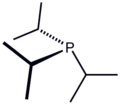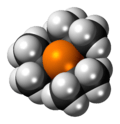Triisopropylphosphine
| |||
| Names | |||
|---|---|---|---|
| Other names
Triisopropylphosphine PiPr3 Pi-Pr3 | |||
| Identifiers | |||
| 6476-36-4 | |||
| 3D model (Jmol) | Interactive image | ||
| ChemSpider | 73055 | ||
| ECHA InfoCard | 100.026.667 | ||
| PubChem | 24863218 | ||
| |||
| |||
| Properties | |||
| C9H21P | |||
| Molar mass | 160.24 g mol−1 | ||
| Appearance | colourless liquid | ||
| Density | 0.839 g/mL | ||
| Boiling point | 81 °C (178 °F; 354 K) (22 mm Hg) | ||
| good in alkanes | |||
| Hazards | |||
| Main hazards | spontaneously flammable | ||
| Except where otherwise noted, data are given for materials in their standard state (at 25 °C [77 °F], 100 kPa). | |||
| | |||
| Infobox references | |||
Triisopropylphosphine is the tertiary phosphine with the formula P(CH(CH3)2)3. Commonly used as a ligand in organometallic chemistry, it is often abbreviated to Pi-Pr3 or PiPr3. This ligand is one of the most basic alkyl phosphines with a large ligand cone angle of 160.[1]
Pi-Pr3 is similar to the more frequently used tricyclohexylphosphine. The triisopropyl derivative however, is a liquid at room temperature and more soluble in hydrocarbons.
References
- ↑ C. A. Tolman (1977). "Steric Effects of Phosphorus Ligands in Organometallic Chemistry and Homogeneous Catalysis". Chem. Rev. 77 (4): 313–348. doi:10.1021/cr60307a002.
This article is issued from Wikipedia - version of the 7/16/2015. The text is available under the Creative Commons Attribution/Share Alike but additional terms may apply for the media files.

